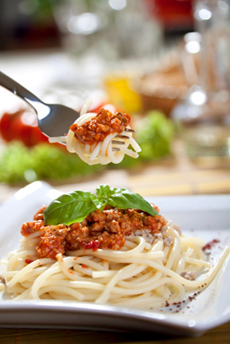 Make a simple tomato sauce, or add meat for Bolognese sauce. Photo by Trutenka | IST. Make a simple tomato sauce, or add meat for Bolognese sauce. Photo by Trutenka | IST.
|
ALISSA DICKER-SCHRIEBER is a food writer and teacher of the culinary arts in New York City. Her cooking lessons are available at TheKitchenista.com.
|
|
March 2011
|
 |
Homemade Pasta Sauce
A Very Easy Recipe
CAPSULE REPORT: Before spending money on bottled pasta sauce, try your hand at making your own. It’s easy. If you’ve ever wanted to make your own homemade pasta sauce, here’s your opportunity. Make extra and freeze it.
Overview
We love this light, fresh-tasting marinara sauce. It’s a basic tomato sauce—tomatoes, olive oil and garlic—seasoned fresh basil and oregano.
A classic Bolognese sauce is made with carrots, celery and onion plus ground veal and pork, and often pancetta (Italian bacon). In this easy recipe, you can brown your ground meat of choice (beef, chicken, pork, turkey) and brown it to make a simple meat sauce.
This recipe makes 3 cups of sauce (will coat enough pasta for 4-6 people).
Homemade Pasta Sauce Recipe
Ingredients
- 1 large can (28 ounces) crushed tomatoes (San Marzano tomatoes
are well worth going out of your way for)
- 1 medium yellow onion
- 1 shallot (optional)
- 4-5 garlic cloves
- 1/4 cup plus up to 2 tablespoons extra virgin olive oil
- 2 pinches red pepper flake
- Freshly ground pepper
- 3 large basil leaves, chopped
- ½ teaspoon dried oregano
- Sea salt
Optional Additions (Choose One)
- Ground meat: 16 ounces, browned in olive oil before adding onion and shallot
- Mushrooms: 16 ounces, sautéed with onion and shallot
Equipment
- Can opener
- Cutting board
- Large frying pan (10- to 12-inches) or saucepan
- Sharp kitchen knife
- Wooden spoon, tongs or rubber spatula
Preparation
- Open the can of tomatoes. Peel and chop the onion. Peel and slice the garlic and shallot.
- Heat a large frying pan or a saucepan over medium-high heat until the pan warms up. (On very powerful stoves, this will happen in a matter of seconds, while on weaker stoves, it may take a couple minutes. A good way to check: add a splash of water to the pan. If the water bubbles up and evaporates right away, then your pan is ready.) You don’t want your pan to get so hot that it starts smoking, though, so be sure to keep an eye on it.
- Pour the extra virgin olive oil into the pan. Add the onion and shallot; stir to combine. Cook, stirring often, for about 3 minutes or until the onion and shallot pieces begin to soften and become translucent. You do not want them to brown.
- Add the garlic and stir to combine. Add basil, oregano and red pepper flakes. For a spicier sauce, add an extra pinch or two; for a milder sauce, use less, or leave them out altogether. The two pinches in this recipe do not make the sauce especially spicy.
- Continue to cook, stirring slowly but constantly, until garlic is very fragrant and the onions, shallots, and garlic have become very soft—about 4 to 5 minutes. You do not want the garlic to brown or burn. If you notice that the mixture is starting to brown, lower the heat on the stove.
- Season generously with freshly ground pepper, about 10-12 cracks from a pepper mill. Stir to combine.
- Carefully pour the tomatoes into the pan. To prevent splattering, keep the can of tomatoes fairly low to the pan and pour slowly. You can also lower the heat under your pan before adding the tomatoes, and then raise it again once you’ve added the tomatoes.
- Stir to combine; then allow the sauce to come to a boil. Lower the heat so that the sauce just simmers. Let the sauce simmer for about 25 to 30 minutes, or until it thickens significantly. Stir occasionally.
- When the sauce is done cooking, most of the tomato pieces will have broken apart and dissolved into the sauce; the onions and garlic will be extremely soft. The sauce will be moist, but should no longer have a watery quality to it. When you scrape a spoon through the sauce, it should hold a line across the bottom of the pan — the sauce should be thick enough that it won’t seep back together. If the sauce seems too liquid, cook it longer. If it seems too thick or pasty, then thin it out by adding a little water and stirring to combine.
- Be sure to taste the sauce to make sure you like how it tastes. If you need to add salt, season lightly with sea salt. Stir to combine and taste again. Repeat if necessary, adding more salt, stirring, and tasting until you’re happy with how the sauce tastes.
- The sauce is now ready to use with your cooked pasta.
- The sauce will keep, refrigerated in an airtight container, for several days. Alternatively, you can freeze the sauce for several months.
Lifestyle Direct, Inc. All rights reserved. Images are the copyright of their individual owners.

|




